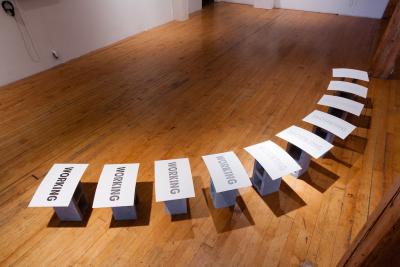Anna Gray + Ryan Wilson Paulsen: Hidden Assembly

On view: November 4, 2016 – January 7, 2017
Jointly presented with the Center for Contemporary Art and Culture at Pacific Northwest College of Art (PNCA).
Opening reception at PNCA: Thursday, November 3, 6-8pm
Opening reception at Newspace: Friday, November 4, 6-8pm
Participating artists/projects:
Art Handlers’ Alliance of New York (AHA-NY) | João Enxuto & Erica Love | Anna Gray & Ryan Wilson Paulsen | Gulf Labor Coalition | Marisa Morán Jahn/Studio REV- | Mary Lum | Michael Mandiberg | Betty Marin | Huong Ngo & Hong-An Truong | Laurel Ptak | Patricia Vázquez with Luciano Aioli, José González, and Eligio Mendoza | Andrew Norman Wilson.
Curator: Yaelle S. Amir
About the Exhibition:
The starting point of the group exhibition Hidden Assembly is the recognition that under capitalism most production is rendered invisible. The labor that people perform is largely obscured or eliminated—an effect heightened by the expanded tech field, global outsourcing, and the rise of precarious work. Hidden Assembly addresses our reconfigured labor market by featuring projects that examine what it means to work in current times. Twelve projects across two venues (Newspace and PNCA) reflect uniquely precarious conditions resulting from capitalist values and governmental strategies; unrecognized producers in the new digital economy; and creative activism that advocates for improved and regulated worker conditions in an age of global and unorganized labor:
The working group Art Handlers’ Alliance of New York has developed new forms of organization and collective bargaining to address the contemporary challenges faced by workers involved in the transport, display, storage, and preservation of art objects; João Enxuto and Erica Love envision a future where contemporary art production is automated to produce works pre-destined for the market, with little input from the individual artist; Anna Gray and Ryan Wilson Paulsen represent the erosion of labor resulting from the rise of a precarious class and a shift in power dynamics within the workforce; Gulf Labor Coalition has worked to expose the conditions and protect the rights of migrant workers during the construction of western museums and universities on Saadiyat Island in Abu Dhabi; Marisa Morán Jahn (Studio REV-) collaboratively formed the transmedia project CareForce to bolster caregivers – America’s fastest growing workforce – and those championing a movement for domestic worker justice; Mary Lum has collected the bottoms of brown-paper bags each stamped with the name of the individual who oversaw its production; Michael Mandiberg documented the inner life and experiences of Amazon’s Mechanical Turk workforce – people performing simple repetitive tasks from all corners of the globe; Betty Marín brings to the fore the identities and stories of seasonal, migrant laborers working in the oft-overlooked Christmas tree industry; Huong Ngô and Hong-Ân Truong track the gendering and racialization of labor through the lens of the experiences of their working-class, refugee mothers; Laurel Ptak’s manifesto Wages for Facebook suggests that Facebook users constitute a massive unpaid workforce generating free content for the social media conglomerate and the businesses it promotes under the guise of personal preferences and social interactions; Patricia Vázquez creatively collaborates with members of the MLK Workers Center in NE Portland – Luciano Aioli, José González, and Eligio Mendoza – to organize day laborers as a distinct labor force; and Andrew Norman Wilson tracks Google’s marginalization of the yellow badge workers responsible for scanning and digitizing books for Google Books.
Hidden Assembly prompts us to assess the human cost of our consumption and the nature of the work we contribute to society. It further demonstrates that – whether organized or unorganized – the conditions of our labor are linked by a system where visibility of the few comes at the expense of invisibility of the masses. By foregrounding the work and conditions of those who produce and contribute to our material and cognitive worlds, and encouraging empathy and self-awareness, this exhibition modestly attempts to resist their systemic erasure in our current age of invisible labor.